Through the Native Trout Stewardship Initiative, the Freshwater Fisheries Society of BC is now in its sixth year of investment to support local stewardship groups seeking to protect and restore small wild-trout streams. To date, the focus has been on urban streams and coastal cutthroat trout. These projects usually also have positive spin-offs for the streams’ other aquatic life, including young salmon, aquatic invertebrates, and amphibians.
This year is no different. Four projects are currently underway to evaluate, protect, and restore coastal cutthroat trout in small streams in, or near, large urban centres on Vancouver Island. Another project targets a tributary of the Upper Bulkley River. Here, we profile two exciting initiatives on southern Vancouver Island that are now underway.
Surprise cutthroat in Bilston Creek
Bilston Creek watershed is a little-known creek complex that runs through the hearts of three southern Vancouver Island municipalities – Langford, Colwood, and Metchosin – before tumbling over impressive Sitting Lady Falls into Witty’s Lagoon. The cascades form a complete barrier to any searun fish, including salmon or cutthroat trout. The little, yet highly productive, creek network nevertheless has the potential to sustain large resident cutthroat trout isolated above the falls. However, this can only be realized with intact habitat and adequate summer water flows. The isolation means that cutthroat are more vulnerable to low water and impacts to habitat (i.e., there is nowhere to go).
Decades of development and water diversions in and around the watershed have resulted in loss of habitat complexity (as stream sections are channelized, wooded areas are removed, and wetlands are drained), degradation of water quality, and much-reduced water flows during the critical summer period. A couple of decades ago, the local Bilston Watershed Habitat Protection Association (BWHPA) invested significant volunteer hours to undertake education and awareness, assessment, protection, and restoration activities. Their efforts culminated in a draft watershed management plan that was never implemented. This planning fell by the wayside as urban and industrial development forged ahead in the area. As of 2022, the status of the population of wild cutthroat trout was unknown.
In 2023, the BWHPA was keen to re-invigorate conservation efforts in the watershed. Given the rate at which the region is being developed, it is critical to secure the protection of the watershed, and to look for opportunities to restore habitat where needed. A preliminary fish survey confirmed that coastal cutthroat trout still existed in the system. Two questions remained. Was this watershed still capable of supporting larger-bodied resident fish that characterized the watershed’s unique value as a salmonid producer? And what kind of numbers persisted?
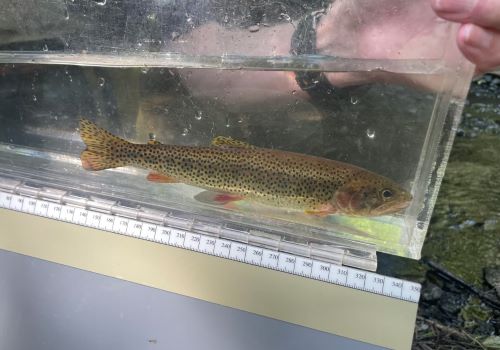
One of the larger cutthroat found in a small pool habitat.
The BWHPA was one of the successful applicants for a grant from the Native Trout Stewardship Initiative for 2024. These monies, in addition to contributions via other partnerships, enabled the BWHPA to pursue a multi-pronged approach to assess fish populations and to undertake restoration activities in sections of the watershed.
In July 2024 the group, with provincial fisheries expertise, investigated the Bilston Creek mainstem. They were thrilled to discover that large, healthy coastal cutthroat trout could still be found in the system. The numbers of fish discovered in one location suggested that the stream is still capable of producing impressive numbers of fish.
One alarming part of this story is that where the fish were found in early July, Bilston Creek was at barely one percent of its mean annual discharge of water; at this time of year, 10% would be ideal. For fish, what this means is that very little habitat or water is available for refuge. As the summer wears on (unless the stream sees rain), the stream will likely be reduced to a series of disconnected small pools, making fish even more vulnerable to warm water and predators.
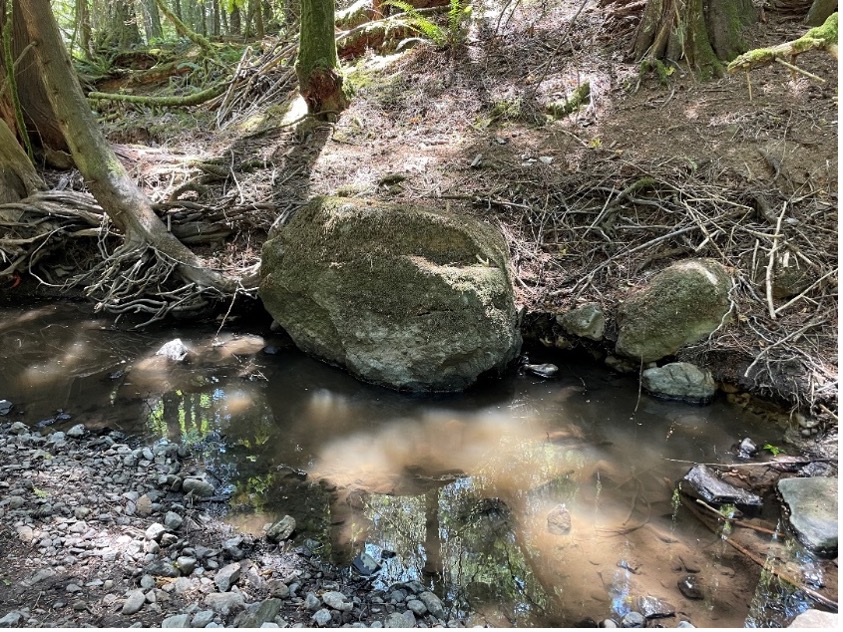
Low water flows in Bilston-Metchosin Creek, home to several dozen cutthroat trout!
The BWHPA will continue to assess the population, and look for ways to protect and restore habitat. They also plan to work with the local municipalities to increase awareness of stream protection requirements for developers, and to find opportunities for collaborative restoration. Ensuring that adequate water flows are available is a complex issue, and low water flows are in part the result of changing summer weather conditions. However, impacts can be moderated with improved water conservation and use. Functioning wetlands (which behave like giant sponges that can release water through dry months) and intact riparian areas (which provide shading and habitat complexity including pools for fish) are key components.
Cutthroat get some attention in a Cowichan Valley watershed
The Somenos Marsh Wildlife Society (in partnership with Cowichan Tribes, the Nature Trust of British Columbia, the Municipality of Cowichan, and other groups) is addressing priority habitats and information gaps identified in a recently completed restoration plan for the Cowichan Valley watershed. There exists very limited information on the status of coastal cutthroat trout in the watershed. As a successful recipient of Native Trout Stewardship Initiative funds, the society hopes to improve our understanding of the abundance and distribution of this key fish species in three major tributaries of Somenos Creek: Bings, Averill, and Richards. These creeks suffer from low summer water flows, eroded riparian areas, and potential barriers to natural fish movement. The society also plans to undertake riparian restoration to better stabilize banks and provide refuge for fish.
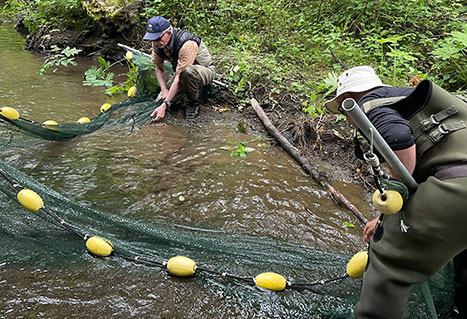
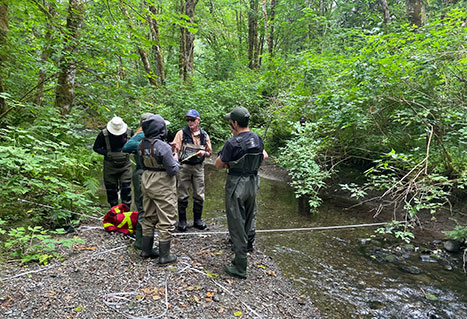
Left: Seining one of the pools for the presence of cutthroat trout. This usually effective method revealed only two fish. (photo credit Gina Hoar). Right: Discussing water flow needs of fish on Bings Creek.
In early July of 2024, the group met with the Freshwater Fisheries Society of BC and a provincial fisheries expert to discuss the project and evaluate a section of Bings Creek. The presence of coastal cutthroat trout was confirmed, and the habitat in this section appears to be intact. However, both habitat and population assessments suggested that pool habitat is very low and limiting to fish production for this otherwise intact section. Low water flows were definitely a contributor, but so was the lack of large woody debris to create pools. As the society continues to evaluate the creeks this summer, they will highlight areas most in need of restoration. The group is also collecting small fin clip samples (humanely from live fish) to include in future genetic assessments of Vancouver Island’s coastal cutthroat trout populations.
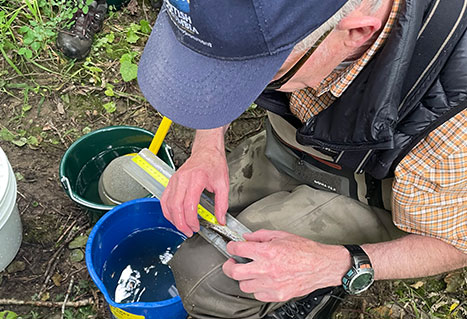
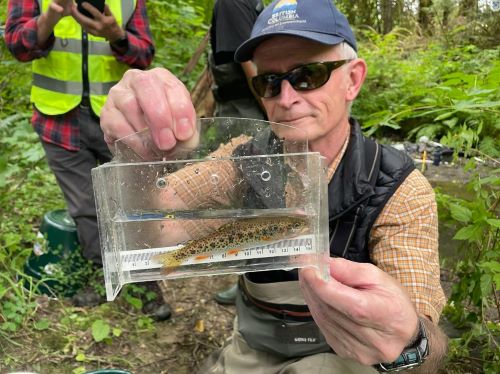
Measuring the catch.
The Freshwater Fisheries Society of BC recognizes the critical role that local stewardship groups and volunteers play in the protection and recovery of watersheds. We are pleased to support this work and encourage members of the public to get involved. The outcomes can be highly rewarding!
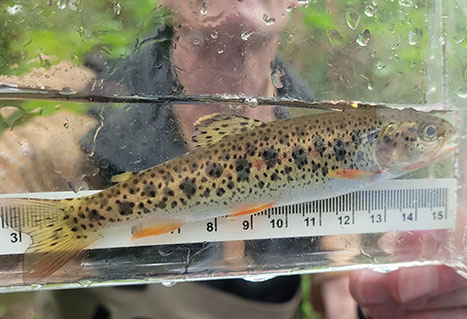
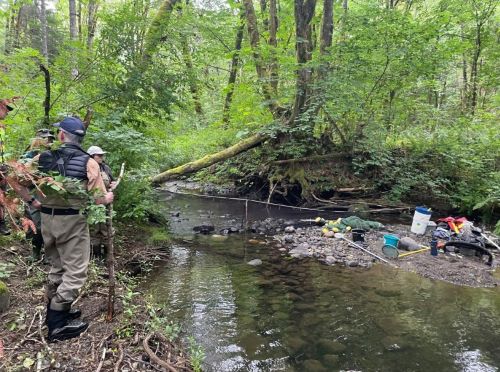
Left: A cutthroat trout collected in the seine net (photo credit Gina Hoar). Right: Setting up to assess fish populations.
For additional information, please see:
- Native Trout Stewardship Initiative information – note that a new call for proposals will be released in September 2025
Author: Sue Pollard, Freshwater Fisheries Society of BC